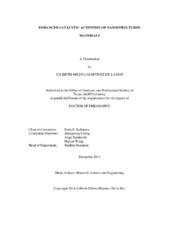| dc.description.abstract | Catalysis has enabled the development of very important industrial processes, especially those related to the petroleum and chemical industries. This has led to a significant influence in the worldwide economy, with 20% of it depending on catalysis. Current reliance of the industrial world on catalysis and rapidly increasing worldwide energy prices have motivated the search for improved catalysts allowing more energy-efficient processes. Catalysts performance is affected by the shape, structure, and chemical composition of the catalysts. Fortunately, the development of nanotechnology has allowed researchers to control the structure and morphology of catalyst nanoparticles, as well as that of solid supports. Even though, these approaches have enhanced the reactivity of materials towards specific reactions, there is still much more room for improvement. In this work, the incorporation of electron-rich environments into the structure of nanocatalysts is proposed as a new approach for the enhancement of the catalytic activity of nanomaterials. This study is conducted in its entirety using computational quantum-based simulations.
The effect of electron-rich regions on activation barriers for the dissociation of diatomic molecules is studied using metallic slit-type pores, finding that electron-rich environments enhance the reactivity of nanomaterials by reducing activation barriers required for the dissociation of molecules. The influence of electronic and geometric effects in the pores is also evaluated. It is found that local geometric characteristics, such as stacking planes forming the pore, and the presence of step-like defects influence adsorption energies and barriers for dissociation of molecules. Additionally, electrons inside the metallic pores have energies close to the Fermi-energy of the metal surfaces, which may allow tuning their energies for interactions with LUMO anti-bonding orbitals of specific molecules.
Subsequently, electron-rich regions are incorporated into a 3D nanostructured material (Pt22/NPG). This proposed catalyst shows enhanced reactivity towards the dissociation of gas-phase molecules. Additionally, Pt22/NPG may display enhanced reactivity, even when electron-rich regions do not interact with the molecules of interest, due to the good dispersion of Pt-clusters. Therefore, the incorporation of electron-rich environments into nanocatalysts is shown to be an efficient approach for the enhancement of the catalytic activity of nanomaterials. | en |


